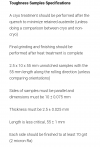Way-Barney
Gold Member
- Joined
- Jun 4, 2023
- Messages
- 773
I have 2 steels
Steel A - Hardness after austenitization 66 - temper to 62 - toughness is 10 ftlb
Steel B - Hardness after austenitization 65 - temper to 62 - toughness is 30 ftlb
If I am happy with toughness of 10 ftlb can I just leave steel B untempered and still get roughly same toughness as steel A but at HRC 65, why should I bother tempering steel B?
Steel A - Hardness after austenitization 66 - temper to 62 - toughness is 10 ftlb
Steel B - Hardness after austenitization 65 - temper to 62 - toughness is 30 ftlb
If I am happy with toughness of 10 ftlb can I just leave steel B untempered and still get roughly same toughness as steel A but at HRC 65, why should I bother tempering steel B?

